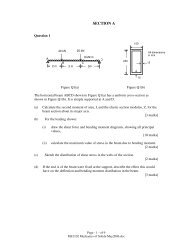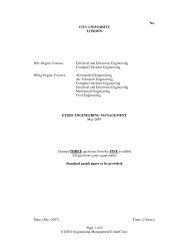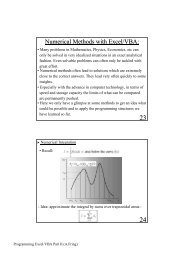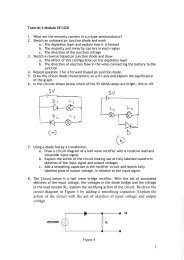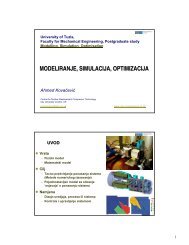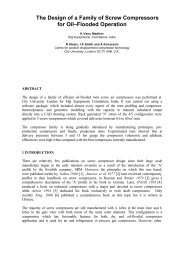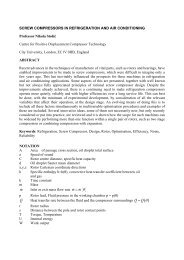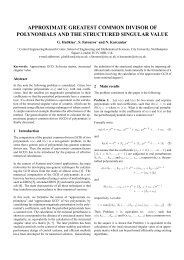Stochastic Modelling Solutions to Exercises on Time Series∗
Stochastic Modelling Solutions to Exercises on Time Series∗
Stochastic Modelling Solutions to Exercises on Time Series∗
Create successful ePaper yourself
Turn your PDF publications into a flip-book with our unique Google optimized e-Paper software.
The process is arbitrarily started at t = 0 with X 0 = x 0 and X j = 0 for j ≤ −1.<br />
Hence, Z 0 = x 0 and Z j = 0 for j ≤ −1. Therefore,<br />
∑t−1<br />
X t = 0.4 j Z t−j + x 0 0.4 t .<br />
j=0<br />
{Z t } is a sequence of zero-mean random variables. Hence, EX t = x 0 0.4 t for t ≥ 0.<br />
(ii) Note that<br />
and that<br />
and also that<br />
X t+k − EX t+k =<br />
∑t−1<br />
X t − EX t = 0.4 j Z t−j<br />
t+k−1<br />
∑<br />
j=0<br />
j=0<br />
0.4 j Z t+k−j =<br />
∑t−1<br />
j=−k<br />
0.4 j+k Z t−j<br />
Cov [X t , X t+k ] = E {(X t − EX t )(X t+k − EX t+k )} .<br />
For k ≥ 0,<br />
⎧<br />
⎨∑t−1<br />
Cov [X t , X t+k ] = E 0.4 j Z<br />
⎩<br />
t−j ×<br />
j=0<br />
∑t−1<br />
j=−k<br />
⎫<br />
⎬<br />
0.4 j+k Z t−j<br />
⎭ = ∑t−1<br />
σ2 Z 0.4 j 0.4 j+k<br />
(where σZ<br />
2 = VarZ t) because {Z t } is a sequence of zero-mean independent and<br />
identically distributed random variables. Hence,<br />
for k ≥ 0 and t ≥ 0.<br />
Cov [X t , X t+k ] = σ 2 Z0.4 k (1 − 0.4 2t )/(1 − 0.4 2 ) (4)<br />
(iii) The process is not stati<strong>on</strong>ary for t < ∞ as both EX t and Cov [X t , X t+k ] vary<br />
with t.<br />
(iv) The process is stati<strong>on</strong>ary in the limit since the magnitude of the root of the characteristic<br />
equati<strong>on</strong> 1 − 0.4z = 0 is 2.5 and |2.5| > 1.<br />
As t → ∞, EX t = x 0 0.4 t → 0 and Cov [X t , X t+k ] → σ 2 Z 0.4k /(1 − 0.4 2 ) and<br />
VarX t → σ 2 Z /(1 − 0.42 ).<br />
In the limit, the au<str<strong>on</strong>g>to</str<strong>on</strong>g>correlati<strong>on</strong> coefficient ρ k = Cov [X t , X t−k ] /VarX t = 0.4 k .<br />
(v) Suppose that the initial value x 0 at time 0 is itself a random variate that is normally<br />
distributed with zero mean and variance σ 2 Z /(1−0.42 ). This distributi<strong>on</strong> is the same<br />
as that of ˜X t ∀ t in the stati<strong>on</strong>ary AR(1) process { ˜X t } given by ˜X t = 0.4 ˜X t−1 +Z t .<br />
One may therefore choose <str<strong>on</strong>g>to</str<strong>on</strong>g> put x 0 = ˜X 0 = ∑ ∞<br />
j=0 Z −j0.4 j .<br />
Since X t = ∑ t−1<br />
j=0 0.4j Z t−j + x 0 0.4 t , it follows that<br />
X t =<br />
∑t−1<br />
∑<br />
∞<br />
0.4 j Z t−j + 0.4 t Z −j 0.4 j =<br />
j=0<br />
j=0<br />
j=0<br />
∞∑<br />
0.4 j Z t−j .<br />
In other words, an initial c<strong>on</strong>diti<strong>on</strong> that is random and taken from N(0, σ 2 Z /(1 −<br />
0.4 2 )) yields an AR(1) process that is stati<strong>on</strong>ary ab initio.<br />
j=0<br />
4



